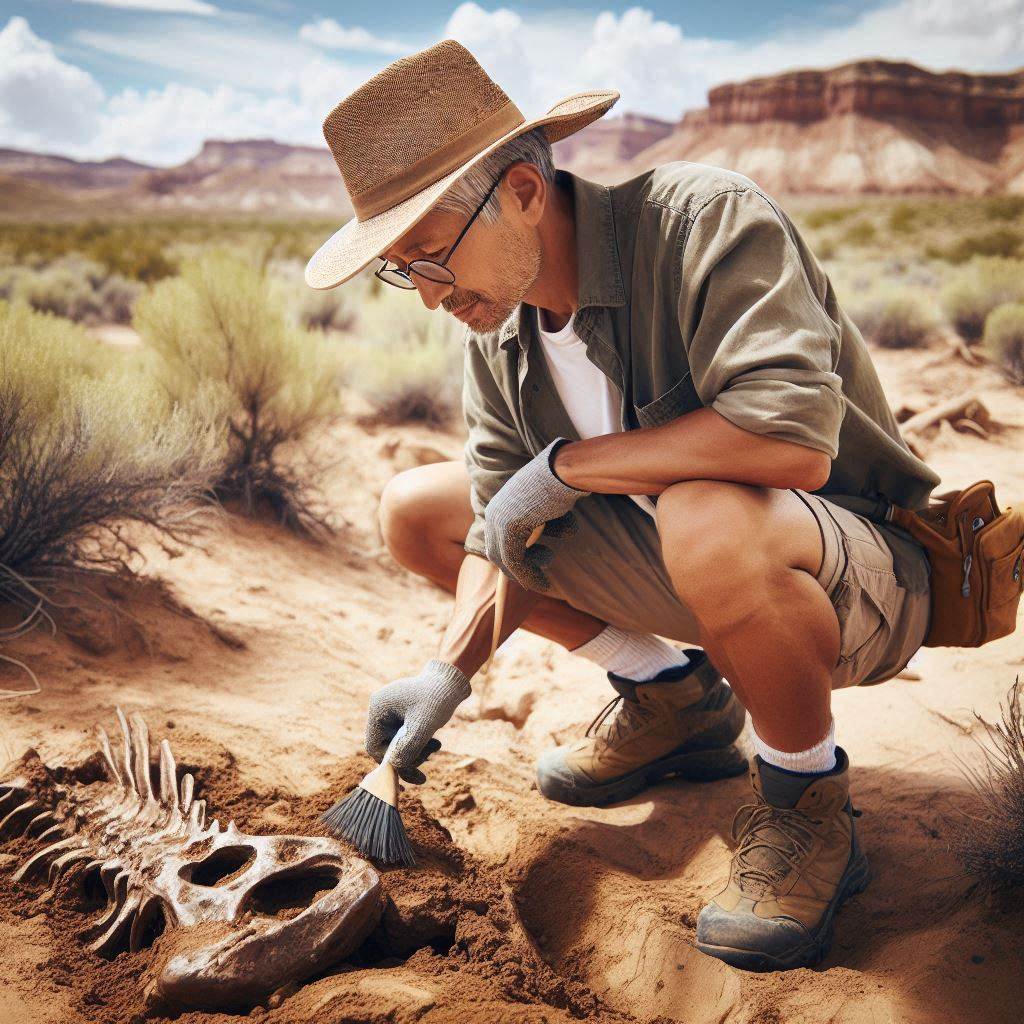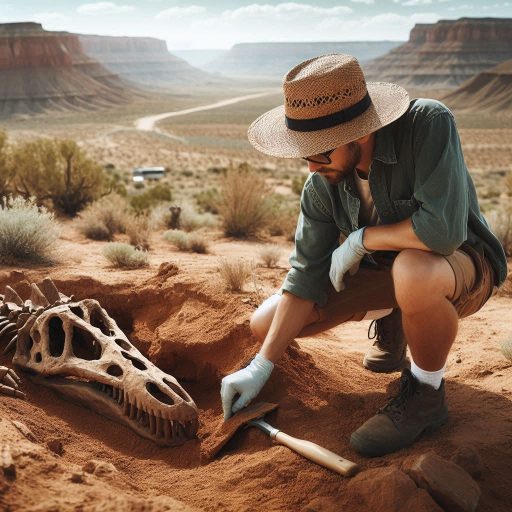Introduction
Paleontology is the scientific study of ancient life through the examination of fossils.
This fascinating field encompasses the exploration of organisms that lived millions of years ago, providing crucial insights into Earth’s history and evolutionary processes.
Paleontologists analyze fossilized remains, including bones, shells, and imprints, to reconstruct past ecosystems and understand the characteristics of extinct species.
However, traditional methods often limited the scope and accuracy of research in this discipline.
In recent years, technology has become a driving force in advancing paleontological studies.
Innovative imaging techniques, such as computed tomography (CT) scans, enable researchers to examine fossils in remarkable detail.
These non-destructive methods allow scientists to visualize internal structures without damaging the specimens, uncovering hidden features that were previously inaccessible.
Such advancements have revolutionized how paleontologists interpret the biology and ecology of ancient organisms.
Moreover, Geographic Information Systems (GIS) have transformed how researchers map fossil locations.
These powerful tools facilitate the analysis of spatial data, helping scientists track changes in biodiversity and climate over time.
By visualizing how ancient ecosystems evolved, paleontologists can make connections between environmental shifts and the emergence or extinction of various species.
Evolution of technology in paleontological studies
Overview of the tools and techniques used in the past
The history of paleontological studies dates back to the early 19th century, where researchers relied on basic tools such as hammers, chisels, and brushes to uncover fossils.
These early methods were limited in their ability to extract delicate specimens without causing damage.
Over time, the field evolved, and new techniques were developed to improve the accuracy and efficiency of fossil excavation.
Manual labor was gradually replaced by more sophisticated tools like pneumatic chisels and microscopes.
This shift allowed scientists to uncover fossils with greater precision and detail.
Advancements in technology and their impact on research efficiency
In recent decades, technology has revolutionized paleontological studies, transforming the way researchers approach their work.
One of the most significant advancements is the use of 3D scanning and printing technology.
This innovation allows scientists to create detailed digital replicas of fossils, making it easier to study and analyze them without risking damage to the original specimens.
Additionally, the development of high-resolution imaging techniques has enabled researchers to visualize internal structures of fossils non-invasively.
CT scanning, for example, provides detailed 3D images of fossils’ internal anatomy, offering valuable insights into their evolutionary adaptations and biology.
Furthermore, the advent of molecular techniques, such as ancient DNA analysis, has unlocked new possibilities in paleontological research.
By extracting genetic material from fossils, scientists can trace evolutionary relationships, reveal evolutionary patterns, and even uncover extinct species’ genetic information.
With the help of advanced technology, paleontologists can now conduct research more efficiently and accurately than ever before.
These tools have not only revolutionized the field but also opened up new avenues for discovery and understanding of the Earth’s prehistoric past.
Digital modeling and reconstruction
Use of 3D Scanning and Modeling in Studying Fossils
The use of technology in paleontology has transformed how researchers study fossils.
One of the most exciting advancements is 3D scanning and modeling.
This technology allows paleontologists to create detailed digital representations of fossils.
Using laser scanning, they capture precise measurements and surface textures of specimens.
This method preserves intricate details that may be lost during traditional handling or preparation.
3D models enable scientists to manipulate and analyze fossils in ways that were previously impossible.
Researchers can rotate, zoom in, and inspect specific features of a fossil without risking damage.
This flexibility enhances the study of complex anatomical structures and relationships between species.
Additionally, 3D modeling allows for comparisons between different fossils, aiding in evolutionary studies.
Paleontologists can share digital models with colleagues worldwide, fostering collaboration.
By providing remote access to 3D scans, researchers can discuss findings and compare results in real time.
This collaborative approach accelerates research and broadens the scope of paleontological studies.
Institutions can also store these digital assets in online repositories, making them available for future research and education.
Benefits of Creating Accurate Digital Reconstructions of Ancient Species
Creating accurate digital reconstructions of ancient species offers numerous benefits.
First, it helps visualize extinct organisms in a detailed manner.
These reconstructions provide insights into the size, shape, and appearance of species that lived millions of years ago.
Understanding these characteristics contributes to our knowledge of evolutionary history and environmental adaptations.
Digital reconstructions also allow for simulations of how ancient species may have moved and interacted within their ecosystems.
By analyzing bone structure and joint articulations, scientists can create biomechanical models.
This information sheds light on behaviors, locomotion, and ecological roles of extinct species.
Researchers can explore questions about predator-prey dynamics and habitat preferences, enhancing our understanding of ancient ecosystems.
Moreover, 3D reconstructions serve as valuable educational tools.
Museums and educational institutions can display digital models, allowing visitors to engage with ancient species interactively.
Virtual reality experiences enable users to explore fossils up close, deepening their appreciation for paleontology.
These experiences can inspire future generations of scientists and foster a love for natural history.
Digital reconstructions also play a critical role in conservation efforts.
By creating accurate models of rare or fragile fossils, researchers can reduce the need for physical handling.
This practice minimizes wear and tear on valuable specimens while preserving data for future studies.
Additionally, digital models can be used in research and development, leading to innovative approaches to paleontological problems.
Remote sensing and satellite imaging
Utilization of Satellite Technology to Discover New Fossil Sites
Technology significantly impacts paleontological studies, especially satellite technology.
Researchers now use satellite imagery to identify potential fossil sites from above.
This innovative approach enables scientists to cover vast areas quickly.
Traditional fossil hunting requires extensive fieldwork, often limiting discoveries to accessible locations.
Satellite technology, however, allows paleontologists to explore remote or difficult-to-reach areas efficiently.
By analyzing satellite images, researchers can observe geological features indicative of fossil-bearing formations.
Changes in vegetation, soil color, and topography often signal the presence of fossils.
Using this technology, paleontologists can prioritize areas for field surveys.
This method reduces time and effort spent on unproductive sites.
Additionally, satellite imagery helps scientists identify patterns in fossil distribution across regions.
The ability to detect landform changes over time enhances fossil exploration.
For example, erosion or landslides can expose previously buried fossils.
Satellite monitoring provides valuable data on these changes, guiding paleontologists to new discoveries.
Moreover, the technology can help track environmental changes that affect fossil preservation.
This information is crucial for understanding past ecosystems and the factors influencing fossil formation.
Advantages of Remote Sensing in Mapping Geological Formations
Remote sensing plays a vital role in mapping geological formations.
By utilizing various satellite sensors, researchers obtain high-resolution images of Earth’s surface.
These images reveal critical geological features that traditional mapping methods may overlook.
Remote sensing allows scientists to analyze large areas in a fraction of the time.
One major advantage of remote sensing is its ability to penetrate dense vegetation.
Many fossil sites lie beneath thick forest canopies, making access challenging.
Remote sensing techniques, such as LiDAR, can cut through vegetation and reveal underlying geological structures.
This capability opens up new opportunities for discovering hidden fossil deposits.
Furthermore, remote sensing enables the identification of specific rock types associated with fossil formation.
Different geological formations contain varying fossil types.
By analyzing the spectral data from satellite images, researchers can pinpoint areas with high fossil potential.
This targeted approach improves the efficiency of fossil hunting.
Another significant advantage is the ability to monitor changes in geological formations over time.
Remote sensing data can show how landscapes evolve due to natural processes or human activities.
Understanding these changes helps paleontologists make informed decisions about site preservation.
It also aids in predicting where new fossils may be uncovered in the future.
Read: Earning Potential: Chemist Salaries Across US States
DNA analysis and genetic sequencing
One of the most significant impacts of technology on paleontological studies is the application of genetic technology in understanding evolutionary relationships.
DNA analysis and genetic sequencing have revolutionized the field of paleontology by providing researchers with a powerful tool to uncover the genetic relationships between ancient species.
Application of genetic technology in understanding evolutionary relationships
By analyzing the DNA of ancient organisms, researchers can determine how different species are related to each other and how they have evolved over millions of years.
This has allowed paleontologists to reconstruct the evolutionary paths of various species and understand how they have adapted to changing environments over time.
Genetic technology has also been instrumental in tracing the origins of different species and identifying the genetic mutations that have led to the diversity of life on Earth today.
By comparing the DNA of modern species with that of their ancient ancestors, researchers can gain insights into the processes of evolution and speciation.
Examples of how DNA analysis has reshaped our understanding of prehistoric life
One of the most notable examples of how DNA analysis has reshaped our understanding of prehistoric life is the discovery of Neanderthal DNA in modern humans.
By sequencing the DNA of Neanderthals, researchers have been able to identify the genetic contributions that Neanderthals made to the modern human gene pool.
In addition, DNA analysis has provided insights into the relationships between different species of early humans, such as Homo sapiens, Homo neanderthalensis, and Homo erectus.
By comparing the DNA of these species, researchers have been able to reconstruct their evolutionary histories and understand how they are related to each other.
Furthermore, DNA analysis has helped paleontologists to identify previously unknown species and determine how they are related to other known species.
By analyzing the DNA of ancient fossils, researchers can uncover the genetic signatures of different species and determine how they fit into the broader evolutionary tree of life.
In essence, DNA analysis and genetic sequencing have had a profound impact on paleontological studies by providing researchers with a powerful tool to understand evolutionary relationships and reconstruct the evolutionary histories of ancient species.
This technology has reshaped our understanding of prehistoric life and continues to revolutionize the field of paleontology.
Read: Essential Skills and Tools for Modern Chemists in America
Transform Your Career Today
Unlock a personalized career strategy that drives real results. Get tailored advice and a roadmap designed just for you.
Start NowArtificial Intelligence and Machine Learning
Role of AI in Analyzing Massive Amounts of Paleontological Data
Technology has significantly transformed paleontological studies, particularly with the advent of artificial intelligence (AI).
Paleontologists now face a wealth of data from fossil records, geographical information, and environmental studies.
Analyzing this massive amount of data manually is time-consuming and often inefficient.
AI algorithms can efficiently process and analyze vast datasets, identifying patterns that might otherwise go unnoticed.
Machine learning, a subset of AI, plays a crucial role in this data analysis.
By training algorithms on existing datasets, AI can learn to recognize specific characteristics of fossils, such as shape, size, and composition.
This capability allows paleontologists to classify and catalog new discoveries quickly.
Additionally, AI can assist in recognizing subtle relationships between different fossil specimens, offering insights into evolutionary processes.
AI-powered image recognition tools further enhance paleontological research.
These tools can analyze images of fossils and skeletal remains, classifying them based on established categories.
This analysis streamlines the identification process, enabling paleontologists to focus on research rather than tedious data sorting.
Moreover, AI can assist in the reconstruction of ancient ecosystems by analyzing spatial data, allowing scientists to visualize how various species interacted in their environments.
Potential for AI to Assist in Predicting Future Discoveries or Species Interactions
AI’s impact on paleontology extends beyond data analysis.
It also holds significant potential for predicting future discoveries and understanding species interactions.
By examining existing data, AI can identify areas where fossils are likely to be found.
For instance, algorithms can analyze geological formations, historical climate data, and fossil distribution patterns to suggest promising excavation sites.
This predictive capability can enhance exploration efforts, making fossil hunting more efficient and targeted.
Furthermore, AI can model species interactions within ancient ecosystems.
By analyzing data on known species, including their habitats and dietary preferences, AI can simulate how these species interacted.
These models can offer valuable insights into predator-prey dynamics, competition, and symbiotic relationships in ancient environments.
Understanding these interactions can help paleontologists reconstruct ecological scenarios and gain a deeper understanding of evolutionary processes.
The predictive power of AI also extends to anticipating how environmental changes may have affected species over time.
By simulating various climate scenarios, AI can help scientists understand how past species adapted or failed to adapt.
This knowledge can inform current conservation efforts, providing insights into how modern species might respond to ongoing climate change.
Read: The Role of Chemists in US Environmental and Sustainability Efforts

Virtual reality and augmented reality
Use of VR and AR for interactive educational experiences
Virtual reality (VR) and augmented reality (AR) have revolutionized the field of paleontological studies by providing interactive educational experiences like never before.
These immersive technologies allow users to explore ancient worlds and interact with dinosaurs in ways that were previously unimaginable.
One of the major benefits of using VR and AR in paleontological studies is the ability to bring fossils and extinct creatures back to life.
By creating realistic 3D models of dinosaurs and their environments, researchers can study these ancient organisms in their natural habitats, giving us a glimpse into the past like never before.
Moreover, VR and AR technology can be used to create virtual museums and exhibitions, allowing people from all over the world to explore paleontological collections without having to travel long distances.
This not only enhances access to valuable scientific resources but also helps raise public awareness about the importance of paleontological research.
Enhancing public engagement with paleontological research through immersive technologies
In addition to educational experiences, VR and AR have also proven to be powerful tools for enhancing public engagement with paleontological research.
By allowing people to virtually excavate fossils, reconstruct skeletons, and even interact with virtual dinosaurs, these technologies make science more accessible and fun for audiences of all ages.
Furthermore, museums and research institutions have begun to incorporate VR and AR experiences into their exhibits, attracting a larger and more diverse audience.
These immersive technologies can bring ancient creatures to life in ways that traditional exhibits simply cannot, captivating visitors and sparking their curiosity about paleontology.
Overall, the impact of virtual reality and augmented reality on paleontological studies has been nothing short of revolutionary.
These technologies have not only transformed the way we study the past but have also opened up new possibilities for education, research, and public engagement in the field of paleontology.
Read: Day in the Life: An Environmental Scientist‘s Typical Day
Challenges and limitations of technology in paleontology
Ethical Concerns Related to DNA Analysis on Ancient Specimens
The advancement of technology has transformed paleontological studies, especially through DNA analysis of ancient specimens.
However, this technology raises significant ethical concerns.
One major issue is the potential for contamination.
Researchers must handle ancient DNA with extreme care to avoid modern DNA interference.
Contaminated samples can lead to inaccurate conclusions about ancient organisms and their evolutionary history.
Another ethical concern involves consent.
Many ancient specimens come from indigenous lands or sacred sites.
Researchers must respect the cultural heritage of these communities and seek permission before conducting DNA analysis.
Failure to do so can lead to conflicts and distrust between scientists and local populations.
Moreover, the implications of resurrecting ancient organisms raise ethical questions.
With advancements in synthetic biology, the possibility of bringing extinct species back to life becomes more feasible.
This concept, often called “de-extinction,” poses ethical dilemmas regarding biodiversity and ecosystem balance.
Resurrecting species could disrupt existing ecosystems and harm current species.
Scientists must consider these potential consequences before pursuing such endeavors.
Additionally, the ownership of genetic data presents ethical challenges.
As researchers analyze ancient DNA, questions arise about who has the right to access and use this information.
Transparency and collaboration among scientists are crucial to addressing these issues.
Researchers must establish clear guidelines on data sharing to promote ethical practices in the field.
Accessibility Issues for Researchers in Developing Countries or Remote Areas
Accessibility to advanced technology poses significant challenges for paleontological researchers, especially in developing countries and remote areas.
Many researchers in these regions struggle to access the latest DNA analysis tools and resources.
This gap hinders their ability to conduct comprehensive studies on ancient specimens.
Limited funding also affects research opportunities.
Many institutions in developing countries lack financial resources to invest in cutting-edge technologies.
As a result, local researchers often miss out on valuable opportunities to collaborate with international teams.
This situation exacerbates disparities in paleontological research and knowledge.
Infrastructure challenges further complicate accessibility.
Remote areas may lack reliable internet access and transportation options.
These limitations make it difficult for researchers to share findings and collaborate with peers globally.
Consequently, valuable insights from these regions may go unnoticed.
In response to these challenges, international collaborations can provide crucial support.
Partnerships with established institutions can help improve access to technology and resources.
These collaborations can facilitate training programs, enabling local researchers to develop their skills and expertise.
By investing in capacity building, the global scientific community can empower researchers in developing regions.
Furthermore, innovative solutions, such as mobile laboratories, can improve access to technology.
These labs can bring advanced equipment to remote areas, enabling researchers to conduct analyses on-site.
This approach reduces logistical challenges and enhances research capabilities.
Uncover the Details: Benefits of a Career in Hydrology and Water Science
Future outlook: The integration of technology and paleontological studies
Predictions for How Technology Will Continue to Shape the Field in the Coming Years
As technology continues to evolve, we can expect even more advancements in paleontology.
Machine learning and artificial intelligence (AI) will likely play significant roles in analyzing large datasets.
These technologies can identify patterns and correlations that might be challenging for humans to discern.
Predictive modeling will also improve, allowing paleontologists to forecast where significant fossil discoveries may occur.
This capability could lead to more targeted and efficient excavations.
Additionally, advancements in molecular technology may unlock new avenues in paleogenomics.
Analyzing ancient DNA will provide insights into the evolutionary relationships between extinct and living species.
This research could redefine our understanding of species development and adaptation over time.
As we continue to harness these technologies, the field of paleontology will become increasingly dynamic and interdisciplinary.
Importance of Maintaining a Balance Between Traditional Fieldwork and Technological Advancements
Despite these exciting advancements, it is crucial to maintain a balance between traditional fieldwork and technological innovations.
Fieldwork remains the foundation of paleontology, allowing scientists to collect firsthand data and observe natural contexts.
The experience gained through traditional methods is invaluable for understanding geological formations and fossil preservation.
Without this grounding, the interpretation of technological findings may lack depth and context.
Furthermore, fieldwork fosters essential skills that technology cannot replicate, such as critical thinking and problem-solving.
Hands-on experience helps paleontologists develop a deeper connection to their work.
This connection is vital for inspiring future generations to pursue careers in paleontology.
While technology enhances research capabilities, it should complement, not replace, the core principles of fieldwork.
Ultimately, the integration of technology in paleontological studies offers exciting possibilities for the field.
As we move forward, embracing these innovations will lead to groundbreaking discoveries.
However, preserving the essence of traditional fieldwork is equally important.
Balancing both aspects will ensure a robust and comprehensive approach to understanding Earth’s prehistoric past.
Delve into the Subject: How to Publish in Nuclear Science Journals
Conclusion
Technology has profoundly transformed the field of paleontology in recent years.
Advanced imaging techniques, such as computed tomography (CT) scans, now enhance fossil analysis and visualization.
These tools allow researchers to examine fossils in three dimensions without damaging the specimens.
Furthermore, 3D printing enables scientists to create accurate models of fossils, allowing for better examination and study in various educational and research settings.
Geospatial technology has revolutionized the way paleontologists map excavation sites.
This innovation leads to more precise mapping and improved data collection.
As a result, researchers can now document fossil locations and geological contexts with greater accuracy.
Additionally, DNA analysis has emerged as a game changer, helping scientists uncover evolutionary relationships among ancient species.
These advancements provide valuable insights into how species have adapted and evolved over millions of years.
The integration of technology into paleontological studies streamlines research processes and expands possibilities within the discipline.
With access to vast databases and collaborative platforms, researchers can share knowledge and discoveries more efficiently.
This interconnectedness fosters collaboration among scientists across the globe, allowing them to learn from one another and build on existing research.




